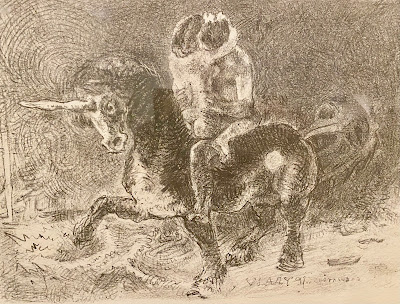While walking up the staircase at Antiguo Colegio de San Ildefonso throw your head back and contemplate "Cortes and Malinche," an ambiguous mural painted by José Clemente Orozco in 1926. It's Adam and Eve, recast as the Mestizo creation myth, with the Spanish conquistador either protecting or restraining the indigenous translator (and reputed mistress) who helped him subdue her people. But what of the man doomed man lying below them? Does he symbolize their progeny or the collateral damage of their relationship?
Here's a detail from another ceiling mural by Orozco, a symbolist. Like Diego Rivera, his compatriot, he clearly admires the proletariat although he was more skeptical about the outcome of the Mexican Revolution.
Let me tell you, there's a lot of art to parse at this former Jesuit boarding school, now a lovely exhibition space in the heart of Mexico City.
This stained glass window, ordered from a Bavarian catalog (!), was installed in 1899 long after the Jesuits had been expelled and the building, once used as a barracks by invading French and American armies, became a non-denominational prep school.
It took a French artist, Jean Charlot, to depict Aztec history in this mural
On the other side of the same staircase, Fernando Leal painted "The Festivities of the Lord of Chalma" which illustrates a mash-up between Catholic and indigenous religious rites. Chalma, Mexico's second-most-visited pilgrimage site, after the Basilica of Our Lady of Guadeloupe, is home to a "black Christ."
I'm guessing Leal's title is ironic. It looks as if this poor horse is being stabbed.
That's the kind of violence you'd expect to find in a work by David Alfaro Siqueiros, a Marxist true believer who merely lampoons the strolling bourgeoisie in this early work.
A very modern fountain flows from the middle of the north courtyard.
The "Spirit of '22," an excellent temporary exhibition which chronicles the Mexican Muralist Movement, includes this portrait of Ricardo Flores Magon, an anarchist and one of the prime movers behind the Mexican Revolution, by Diego Rivera.
A guerrilla leader made it into the exhibit, too, although he looks like a gay caballero to me. Neither of these portraits have ever been publicly displayed before.
 |
| "Hermenegildo Galeana" by Ramón Alva de la Canal (1943) |
The guerrilla and the artist (self-portrait below), who also fought in the revolution, were said to have been very close. You tell me--just look at those eyes!
San Ildefonso also mounted a retrospective of Vlady, a modern, naturalized Mexican muralist whose father had been Trotsky's secretary before he took refuge from Stalin in Mexico with his 20something son. While some of Vlady's work is interesting, it can't compare with that of Rivera, Orozco and Siqueiros.
 |
| "Magiografía Bolchevique (Tríptico trotskiano)" (Detail, 1967) |
 |
| Self Portrait (1967 - 1983) |














No comments:
Post a Comment